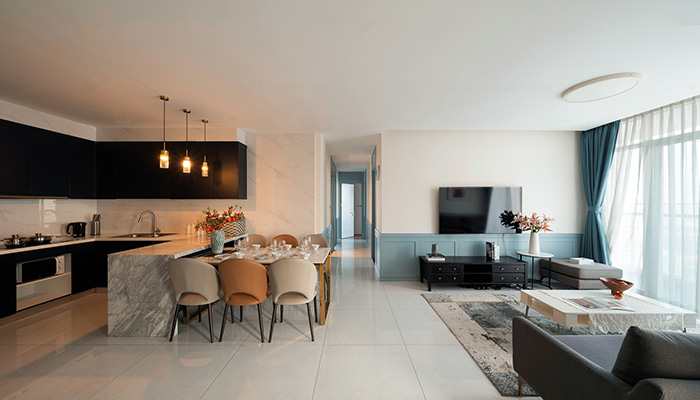Explore the architecture of Tran Thuong Temple, a traditional Festival destination in Ha Nam
Ha Nam, a province in the Red River Delta, is not only famous for its majestic natural beauty but is also a place that preserves the ancient culture of the Vietnamese people. Among the famous historical and cultural relics in Ha Nam, Tran Temple especially attracts tourists because it is not only a sacred place, but also a destination for many traditional festivals.
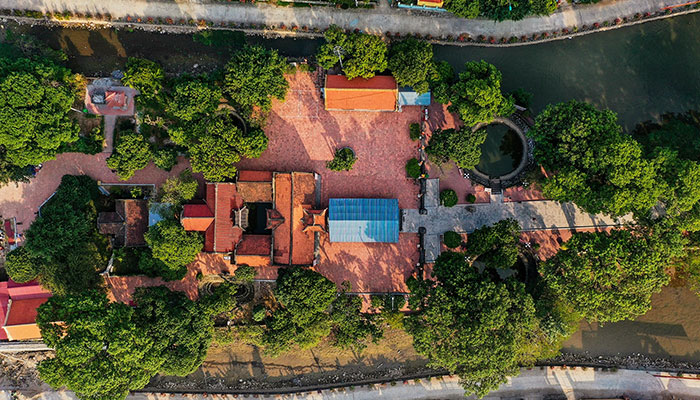
Tran Thuong Temple (or Tran Temple, Temple of Saint Tran) is located on the banks of the Red River, located in Tran Thuong village, Tran Hung Dao commune, Ly Nhan district, Ha Nam province. This place has long been considered the pride of the people of this region, as the place to worship Tran Hung Dao. The temple was built right on the land he used as a food warehouse in the past to serve in the resistance war against the Yuan-Mongol army for the second time. The Ngoc Well in the temple is the place where Tran Hung Dao's bones were buried when he passed away. Tran Temple is attractive because of its architectural features imbued with ancient traditions, with works built in the unique architectural style of ancient Vietnamese people. Exploring Tran Temple, visitors will encounter paintings and statues reflecting national life, history and culture, helping them better understand the heroic past of the Vietnamese people. Every year, thousands of tourists flock to Tran Thuong Temple not only to enjoy the sacred atmosphere, but also to be attracted by the mysterious history here.
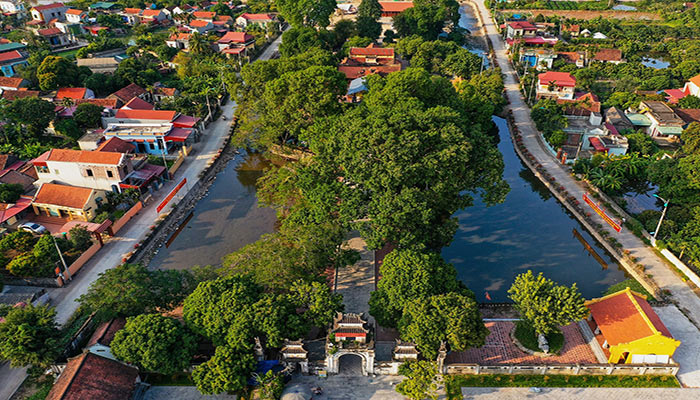
Tran Thuong Temple was originally named Lang Mieu, described as a young woman lying on the riverbank, with the position of "a figure worshipping a phoenix", and is the intersection of "Six Dau Khe" - the convergence centre of 6 Small live fish have advantages in food and are convenient for waterway transportation. With the strategic vision of Tran Hung Dao, this intersection point was chosen as an area to store food and weapons to serve the army in the second war against the Nguyen - Mongol invaders in the year of At Dau 1285. After the victory, Tran Hung Dao returned to the food warehouse area to distribute food to the army and people as a way to show his gratitude to everyone who did not hesitate to face difficulties and stand side by side with the court. In addition, he also provided a living allowance and exempted taxes for the people. Therefore, when he died, the local people built a temple for him at this warehouse location and honoured him as Saint Tran. Since then, the original name Lang Mieu was also renamed Tran Thuong - meaning Tran Dynasty's salary warehouse.
The architectural beauty of Tran Thuong Temple is also a highlight for tourists, it goes hand in hand with the history of recreating the painting for today's generation. Tran Thuong Temple was built on a large area of land, facing south, surrounded by a system of solid bricks and mortar combined with canals, ponds and lakes. The beauty of Tran Thuong Temple is expressed through many different spaces. The architecture of Thuong Temple is designed in the following order: Outer rites - Main road - Inner rites - Yard and screen - Main temple - Model house - Water well.
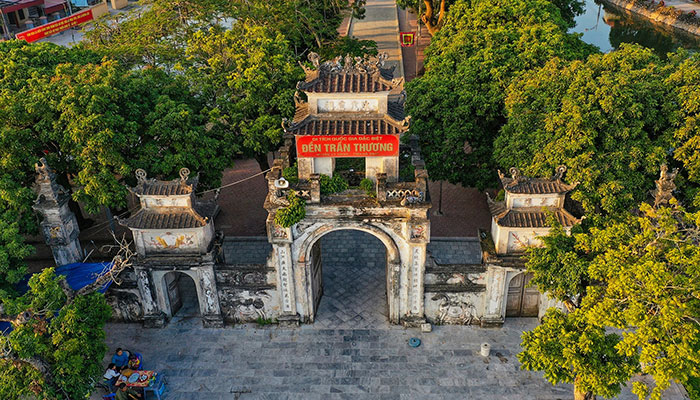
First, the Nghi Gate outside has 3 roof floors, on both sides are typical pillars and 3 entrance gates with the middle gate being the main entrance to the temple. The structure of the outer gate is made of plastered bricks. Each brick plastered on the wall is decorated with beautiful flowers, patterns, and edges. Next is the main road with a length of 50m, 5m wide, on both sides of the road are two rows of green trees creating a feeling of friendliness with nature. Next is the inner ritual gate, built in the form of a square-sectioned pillar made of brick and mortar, decorated with thread. Each pillar is designed with a unicorn facing inward. Passing through the inner Nghi Mon is a temple area of about 600 square metres paved with red bricks. Coming to the main temple, there are Co Lau, Tien Te, Ta Huu Vu, Ho Khau, Central Palace, and Harem with an overall size of 16.8m x 24.18m. Co Lau is located in front of the middle space of Tien Te, Tien Te has 5 compartments and 2 wings, Ho Khau well connects the space with Tien Te. The two left/right houses are connected to the two gables of Tien Te, symmetrically on both sides of Ho Khau well. The Central Palace is located behind Ho Khau well. The harem is the last building connected to the Central Palace. Behind the main temple is the Model House with a "nail" shaped floor plan. The temple has a total of 4 wells, the walls of the wells are built of crushed stone, with steps up and down made of bricks.
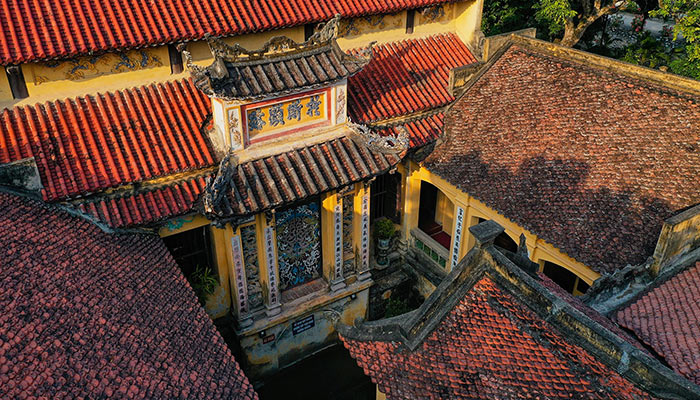
Tourists also come to Tran Temple to immerse themselves in the festivals here. Tran Thuong Temple Festival is one of the largest cultural festivals in Vietnam, the festival brings many unique folk cultural activities. There are two big and famous festivals at the temple: the salary distribution festival at dawn on the full moon day of the first lunar month and the traditional festival in the eighth lunar month every year. In particular, the Tran Temple Salary Distribution Ceremony is held at the hour of the Rat as a way to recreate the military battle scene of the Tran Dynasty's army in ancient times. During the festival, many traditional, special and unique cultural activities take place such as "Phong Dang, Hoa Coc", "Quoc Thai Dan An", "Thanh Dong Performance" - all of the above rituals have the meaning of praying for good fortune. The weather is favourable and windy, in addition, it also reminds of the moral "When drinking water, remember the source" because the Tran dynasty's origins were familiar with river work. Tran Temple's salary distribution festival takes place in 3 processes: first is the procession of food and herbs from the food warehouse into the temple for the ceremony, then the ceremony of lighting torches and incense offerings by delegates and finally the procession of food and herbs into the harem. make a secret ceremony. The symbolic food bags will include 5 types of red beans, green beans, soybeans, red corn, yellow sticky rice and temple seals. Those salary bags reach the hands of tourists to help them pray for peace, happiness and prosperity in the new year.

Ha Nam is one of the attractive options for people to choose as a spring vacation destination. You will not only experience the beauty of historical architecture but also immerse yourself in the traditional culture here. To facilitate your travel and experience, Tien Loc Palace Hotel will be the place to help you rest and experience the best trip. With its location right in the centre of Phu Ly city, you can move to many different locations easily. In addition, Tien Loc Palace is a 3-star hotel with full amenities to serve you most thoughtfully.

.jpg)
